
- SAP NetWeaver Tutorial
- SAP NetWeaver - Home
- SAP NetWeaver - Introduction
- SAP NetWeaver - Architecture
- SAP NetWeaver - Components
- SAP NetWeaver - Release Details
- SAP NW - NW Version in ECC System
- SAP NetWeaver - Setting Up NW
- SAP NW - Installation Options
- Passing Parameters for Installation
- SAP NW - Transport Management
- Managing Background Jobs
- SAP NW - NW Business Client
- SAP NW - Service Configuration
- Business Client Installation
- NWBC Transaction & Navigation
- SAP Application based on NW
- SAP NetWeaver - Portal
- SAP NetWeaver - Create a System
- Enterprise Portal Roles & Group
- SAP NW - Knowledge Management
- SAP NW - KM Administration
- SAP NetWeaver - Developer Studio
- SAP NetWeaver - Web Content
- Process Integration Options
- SAP NetWeaver - Gateway
- SAP NetWeaver - Security
- SAP NetWeaver - PFCG Roles
- SAP NW - Authentication Methods
- SAP NW - Communication Security
- SAP NetWeaver Useful Resources
- SAP NW - Questions and Answers
- SAP NetWeaver - Quick Guide
- SAP NetWeaver - Useful Resources
- SAP NetWeaver - Discussion
SAP NetWeaver - Quick Guide
SAP NetWeaver - Introduction
SAP NetWeaver (SAP NW) describes all the software and services used for 'Business Enablement'. The SAP Business suite, such as ERP Central Component (ECC) or Supplier Relationship Management (SRM), contains the software components for that specific business solution.
Following are the key points about SAP NetWeaver platform −
It is an open technology platform that offers a comprehensive set of technologies for running mission-critical business applications and integrating people, processes, and information.
It is a web-based, open integration, application platform that serves as the foundation for Enterprise Service-Oriented Architecture (Enterprise SOA) and allows the integration and alignment of people, information, and business processes across business and technology boundaries.
It utilizes open standards to enable integration with information and applications from almost any source or technology.
It is the foundation of SAP Business Suite and SAP Business by Design. It also powers partner solutions and custom-built applications.
SAP NW Development
SAP NetWeaver was first introduced by TopTier Software, an Israeli company, in 1997. SAP has acquired this company in the early 2000’s. The first version of SAP NetWeaver was released in 2004 with version NW7.0.
Note − The latest available version is SAP NetWeaver 7.5 released in Q4 2015.
SAP has tied up with various hardware vendors to provide different application components to enhance the capabilities of the NetWeaver platform. SAP Business Warehouse (BW) Accelerator is one of the examples that was developed to improve data load and query performance in SAP BW.
Various application development has been introduced by SAP based on the NetWeaver platform like ABAP Workbench, Web Dynpro, Visual Composer, SAP Solution Manager and NetWeaver Developer Studio (NWDS) based on JAVA stack.
In the following image, you can see key enablement based on SAP NW Platform −
Highly Configurable Business Applications − This includes SAP ECC suite, SAP CRM software suite for Customer Relationship Management, Supply Chain Management and other key modules that are part of SAP Enterprise Resource Planning (ERP) solution.
Business Enablement Applications − This contains business enablement applications like SAP Process Integration (PI), Enterprise Portal, and Business Intelligence software suite.
Common Development and Technology Platform − This contains web development and application development technologies like ABAP Workbench, SAP Web Dynpro, Visual Composer, etc.
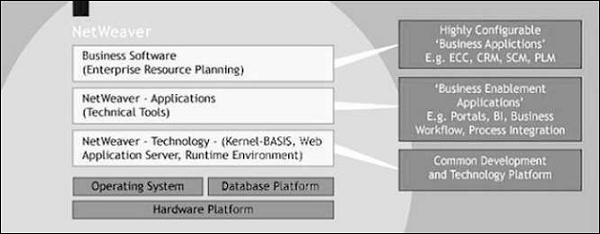
SAP NetWeaver − Advantages
SAP NW is an open platform for managing and configuring business applications for the development of workbench application so you can achieve multiple advantages.
It is based on the Service-Oriented Architecture approach and hence allows you to perform tasks with flexibility. System upgrades can also be performed easily.
With the use of SAP NetWeaver Application server, you can perform analysis and embedded analytics in real time.
Easy development of web applications using tools like ABAP Workbench, Web Dynpro, and NW Development Studio.
A single application platform to manage applications from different providers, implemented in different languages.
Easy implementation and consumption of business logic and SAP Backend system content using web and mobile applications.
Flexible and simple development environment for mobile and web applications using SAP NetWeaver Gateway, SAP UI5 based on JAVA, and HTML5 based Application development.
Easy workflow and management of day-to-day business operations by using SAP Fiori Launchpad based on NetWeaver platform deployment model. Using NetWeaver gateway, developers can create applications that link business users to SAP software from any environment and through any device.
SAP NetWeaver - Architecture
SAP NetWeaver is called a central foundation for SAP software stack and provides a flexible platform for other NetWeaver components such as Process Integrator, Business Intelligence, Enterprise Portal, and also for ABAP and Java applications.
SAP NetWeaver Application Server supports platform-independent web services, business applications, and standards-based development, enabling you to leverage existing technology assets for Web-services-oriented solutions.
All NetWeaver components are built on SAP Web Application Server and components are written in J2EE or ABAP.

SAP NetWeaver − Architecture
SAP NetWeaver is one of central component of entire SAP software stack and provides a platform for the other components, as well as JAVA and ABAP applications.
SAP Application server consists of multiple application server instances and also database servers. With the use of dialog instance, it also contains a message server and an enqueue server.
A dialog instance executed by the user has the following components −
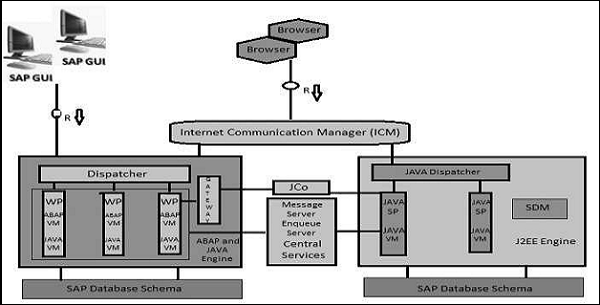
Internal Communication Manager − It is used to process both the client and the server web requests. It supports protocol − HTTP, HTTPS, SMTP.
Dispatcher − Dispatcher is used to distribute the user request to different work processes. If all the work processes are busy, requests are stored in the Dispatcher queue.
Work Processes − These are used to execute Java or ABAP programs.
SAP Gateway − This provides RFC interface between SAP instances.
Message Server − This is used for message communication and also balances the load in SAP system.
SAP NetWeaver - Components
SAP NetWeaver includes a comprehensive set of components, applications, and tools.
SAP NetWeaver Application Server
It supports platform-independent web services, business applications, and standardsbased development, enabling you to leverage the existing technology assets for Webservices-oriented solutions.
Its key features include −
- Proven scalable and comprehensive toolset for managing application platform development.
- Leverage the existing infrastructure skillset.
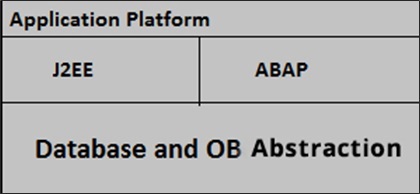
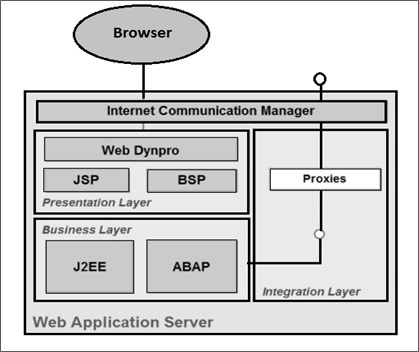
Internet Communication Manager
Internet Communication Manager (ICM) is used to process web and server requests and to set up the connection to the internet using HTTP, HTTPS and SMTP protocol. The requests were sent via Web browser by the users.
A RFC connection is used to connect SAP NetWeaver Application server to Backend system for acquiring and processing the data.
In SAP Web Application Server, SAP Gateway makes the RFC interface between the SAP instances available.
The Message Server is used to process the messages and for load balancing in the SAP system.
Installation Options for the SAP NetWeaver Application Server
For the installation of SAP NetWeaver Application Server, you can select from the following two installation options −
ABAP System − Using this installation method, you can run ABAP programs and also few selected SAP Java applications.
Java System − Using this installation method, you can run J2EE applications but not any ABAP programs
SAP NetWeaver − Business Intelligence
It enables you to integrate data from across the enterprise and transform it into practical, timely business information to drive sound decision making.
SAP NetWeaver − Gateway
It enables developers to create applications that link business users to SAP software from any environment and through any device.
SAP NetWeaver − Master Data Management
It ensures cross-system data consistency and helps integrate business processes across the extended value chain.
SAP NetWeaver − Process Orchestration
It helps improve processes, from simple workflows to integrated processes that span applications and organizational boundaries. It includes capabilities for business process management, business rules management, and process integration.
SAP NetWeaver − Portal
It unifies critical information and applications to provide users with role-based views that span the enterprise, enabling you to take full advantage of your information resources.
SAP Auto-ID Infrastructure
It gives you all the capabilities you need to integrate all automated sensing devices including RFID reader and printers, bluetooth devices, embedded systems, and barcode devices.
SAP NetWeaver − Identity Management
It addresses access and provisioning issues facing a typical enterprise. It creates a new opportunity for integrating business processes, and helps to integrate systems in a heterogeneous IT environment.
SAP NetWeaver − Information Lifecycle Management
It allows you to archive data in a readily accessible format according to regulatory retention rules that you define.
SAP NetWeaver - Release Details
SAP NetWeaver platform and different applications based on NetWeaver technology allows you to use SAP and non-SAP products in a heterogeneous environment. In the following table lists different release details of SAP NetWeaver platform.
SAP NetWeaver 7.0 was first released in 2004. Its latest release is SAP NetWeaver 7.5, which was released in Nov 2015.
| Technology | Release Details |
|---|---|
| SAP NetWeaver Platform | SAP NetWeaver 7.5 SAP NetWeaver 7.4 SAP NetWeaver 7.3 including Enhancement Package 1 SAP NetWeaver 7.3 SAP NetWeaver 7.0 including Enhancement Package 3 SAP NetWeaver 7.0 including Enhancement Package 2 SAP NetWeaver 7.0 including Enhancement Package 1 SAP NetWeaver 7.0 |
| SAP Composition Environment | SAP NetWeaver Composition Environment 7.2 SAP NetWeaver Composition Environment 7.1 including Enhancement Package 1 SAP NetWeaver Composition Environment 7.1 Enterprise Services Repository for SAP NetWeaver CE 7.1 |
| SAP Enterprise Portal, Enterprise Workspaces | SAP NetWeaver Portal, Enterprise Workspaces 1.0 SAP NetWeaver Portal, Enterprise Workspaces 1.1 |
| SAP NetWeaver Adaptive Computing Controller | SAP NetWeaver Adaptive Computing Controller 7.3 SAP NetWeaver Adaptive Computing Controller 7.2 |
| SAP NetWeaver Enterprise Search | SAP NetWeaver Enterprise Search 7.3 SAP NetWeaver Enterprise Search 7.2 |
| SAP NetWeaver Mobile | SAP NetWeaver Mobile 7.1 Including Enhancement Package 1 SAP NetWeaver Mobile 7.1 |
| SAP NetWeaver MDM | SAP NetWeaver Master Data Management 7.1 |
| SAP Process Integration | SAP NetWeaver Process Integration 7.1 Including Enhancement Package 1 SAP NetWeaver Process Integration 7.1 |
| SAP Single Sign-On | SAP NetWeaver Single Sign-On 2.0 SAP NetWeaver Single Sign-On 1.0 |
NW Version in ECC System
As mentioned earlier, SAP NetWeaver includes a comprehensive set of components, applications, and tools. You can check the version of NetWeaver platform in SAP ECC suite.
To check the version of NetWeaver platform −
Step 1 − Login to SAP ECC system using SAP GUI.

Step 2 − Select the system for which you want to check NetWeaver version and login.

Step 3 − To check the version, click the system tab at the top → Status

This will open the System Status Tab.
You can view different details such as Usage Data, Repository Data, and Host Data.
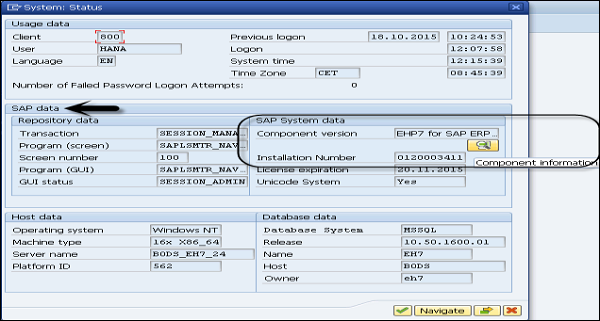
Step 4 − To check the version, under SAP system data → Component Version → Click the Lens icon.
In the next Installed Software screen, under the Installed Software Component Versions, you can find Component name, Release, Service Pack Level, and Support Package.
Step 5 − Under the Release tab, you can check the version of NetWeaver version. In the following screenshot, it is NetWeaver 7.4.
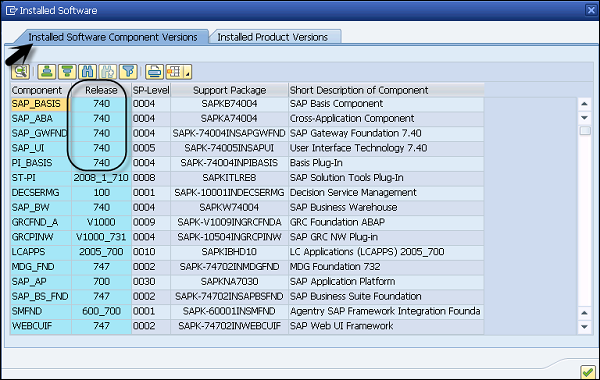
Step 6 − Under the same screen but the next tab, i.e., Installed Product Versions, you can find the version of each component installed on the SAP system. To search the version of SAP NetWeaver, scroll down to find it.
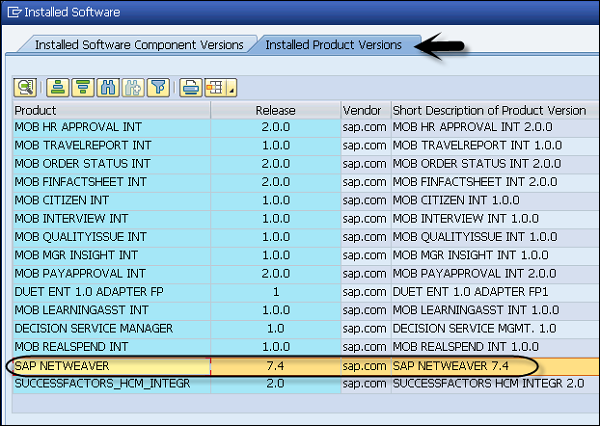
SAP NetWeaver - Setting Up NW
To set up SAP NetWeaver, you have to check SAP NetWeaver Product Availability Matrix (PAM) on SAP Site. This tells you the platform availability, release type and maintenance, and upgrade duration of the product.
Using PAM, SAP publishes the following information about SAP software releases −
- Release type (for example, standard release, early adoption release, or custom development project release)
- Planned availability
- Maintenance durations
- Upgrade paths
- Platform availability, including database platforms and operating systems
To check the platform, maintenance and upgrade, and release details of SAP NetWeaver platform, go to the following SAP PAM site and login using partner ID and password https://apps.support.sap.com/sap/support/pam
To check PAM for SAP NetWeaver 7.4, go to the following link and login using your SID and password.
https://websmp201.sapag.de/~sapidb/011000358700000552252012E
Following information is available on this site −
- OS/DB
- Developer Workplace
- Language Support
- Browser Support
Note − SAP note 1843183 for Release of SAP NetWeaver 7.4.
Operating System/Database PAM for SAP NetWeaver
In the following table, you can find the Operating System and database Product Availability Matrix for SAP NetWeaver platform. Along the Y-axis, it shows the database support, their version, and along the X-axis it shows which Windows OS is supported.
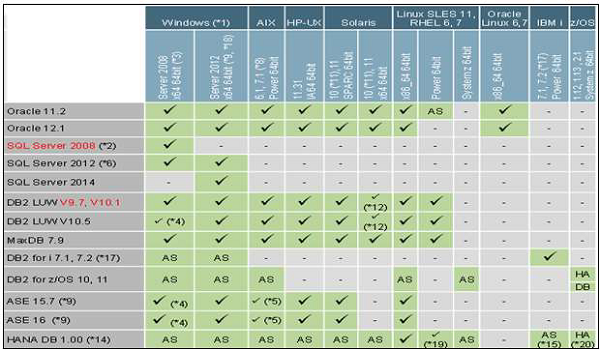
- AS − Application server with whole SAP NetWeaver stack only
- DB − Database Server only
- HA − High Available Solution only
- X64 − x64 and x86_64 represent the same hardware
Desktop and Mobile Browser Support for SAP NetWeaver
Following is the desktop browser support for SAP NetWeaver releases −
Microsoft Internet Explorer
- IE 11 Desktop (recommended)
- IE 11 on Windows 10 support planned for October 2015
- IE 7 - IE 10 until January 2016
Microsoft Edge
- Planned for UI Add-on 2.0 SP1 (SAPUI5 1.32). Down port to UI Add-on 1.0 SP15 (SAPUI5 1.28) planned.
Mozilla Firefox
- Latest Extended Support Release Cycle (recommended)
- Latest Rapid Release Cycle (conditionally supported)
Google Chrome
- Latest Release Cycle for Windows
- Support of NW 7.02, 7.03, 7.30 and higher
Apple Safari
- On OS X for 3 years from the version release date
- Support of NW 7.02, 7.03, 7.30 and higher
Following is the mobile browser support for SAP NetWeaver releases −
- Apple Safari on iPad
- Apple Safari on iPhone
- Google Chrome on Samsung Galaxy Tab/S
- Android browser on Samsung Galaxy Tab/S (A4.4 and higher)
- Windows Phone 8.1 on Nokia Lumia 930 (conditionally supported)
- Windows Phone 10 on Nokia Lumia 930 (planned)
- BlackBerry on BlackBerry Z10/30
Note − Devices and OS version support for 3 years from vendor Release date.
Supported UI technologies −
- SAPUI5 / OpenUI5
- SAP Fiori applications may have different support
SAP NetWeaver Developer Workplace
- Consists of SAP NetWeaver Developer Studio and AS Java with limited platform support
- Local development and test capabilities
- No support for team development
- No tool updates available via Eclipse update sites
- No extension support
Language Support
All information regarding language availability can be found in the Product Availability.
Matrix (PAM) under Technical Release Information → Languages → Product Instance → Display link in Additional Information
SAP NetWeaver - Installation Options
Before you perform the installation, the first step is to check the software and the hardware requirements for the installation. Software requirement includes media for the installation and hardware requirement includes − PC with RAM 16 GB, hard disk space minimum 6080 GB for installation and running the system. If you are planning to create a virtual image, you can allocate an equivalent memory to VM image.
Software Requirement
You can get the software from SAP Marketplace. Go to https://websmp201.sapag.de/#wrapper
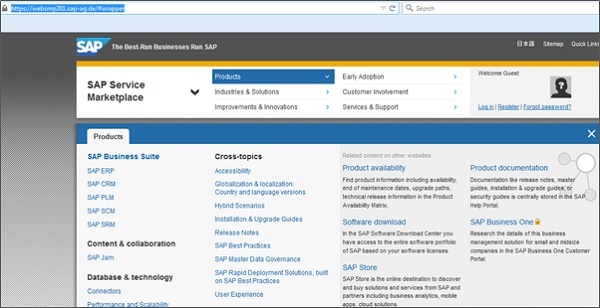
Click the SAP Store icon at the bottom and you will be directed to https://www.sapstore.com/
Click the Log-on button and enter SAP Partner ID details. Once you are logged in, you can see the following screen −
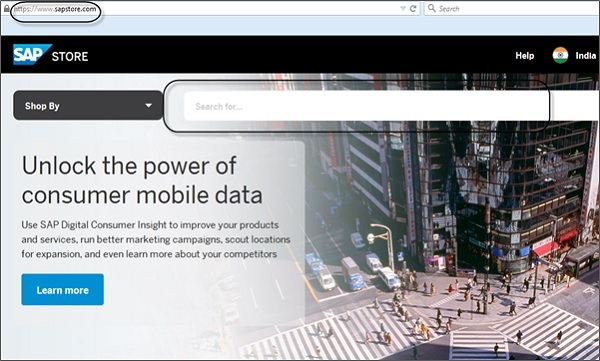
Search for SAP NetWeaver Application Server for ABAP 64-bit trial version.
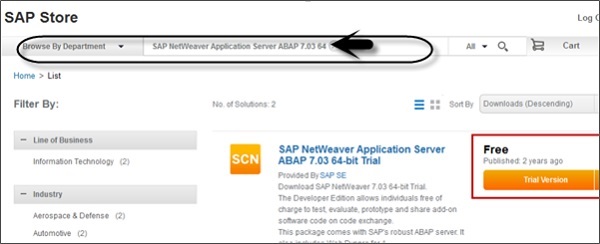
You can also download items from the following SAP Store link for old software products http://sdnweb.sdn.sap.com
The Software Download Search list, is mapping the old SCN Download Catalog items to the new store links. The search box will auto complete your entry and will help you find the item you are looking for.
On the left side, we listed the store solutions number as a reference for searching directly in the store. The SAP Store solution title links to the relevant store solution.
In case you don't find the old package, send an email with the old title and link.
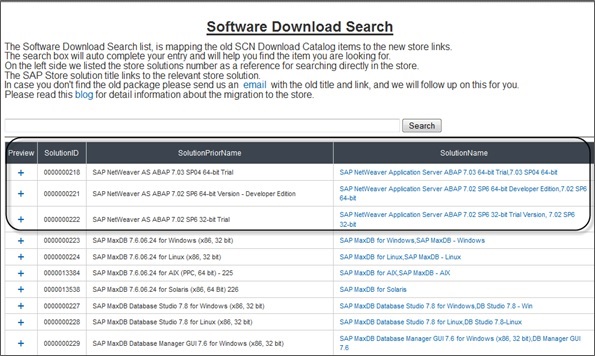
Register your account and enter all the details. Check the Terms and Conditions checkbox.
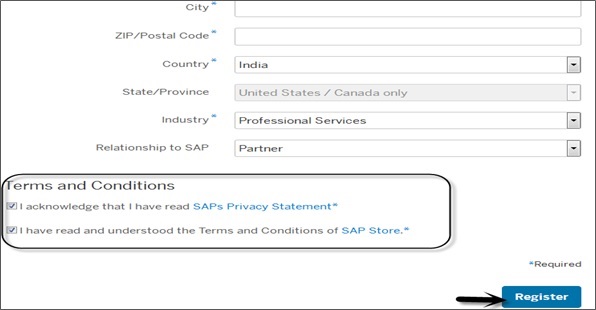
Once you register with SAP Store, SAP provides you a link that contains the file- ABAP_7_03_SP04_64_bit_Trial_3_9_2_GB.rar with a size of around 4 GB. Extract this file to a new folder and you can see the following folders. You have the application installer file to run the installation.
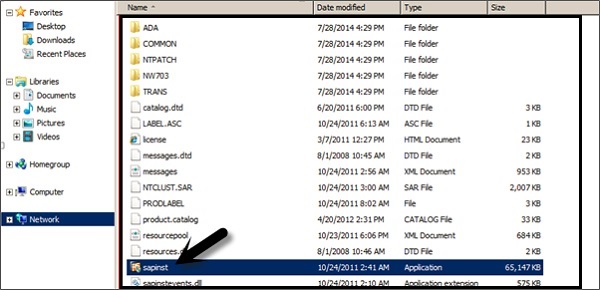
This will open the SAP installation Master Wizard. You need to complete the following steps to finish the installation.
- Choose Option
- Define Parameter
- Summary
- Execute
- Completed
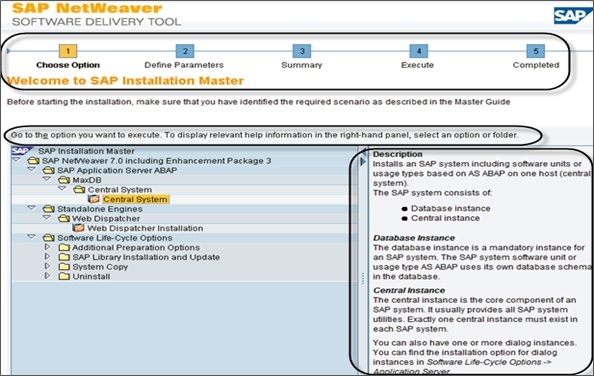
On the left side, you have help for each of the option. Once you make the selection, next is to go to Define Parameter, here accept the end user license agreement EULA → Next.
In the next (following) screen you have to enter the password for all the users. This password will be used for all accounts SAPinst creates and for the secure store key phases. Check F1 help for restrictions and dependencies.
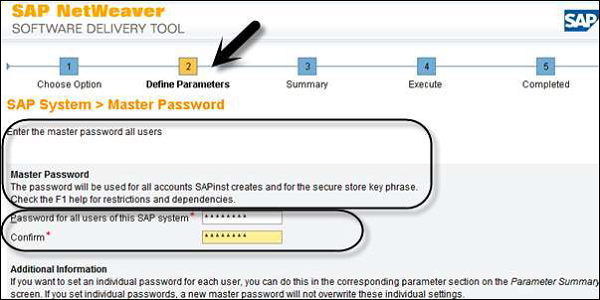
When you click next, in the next window the system will perform a prerequisites checker results. Under the detailed results, you can find the different options −
- Condition
- Result Code
- Severity
- Message
- More Information
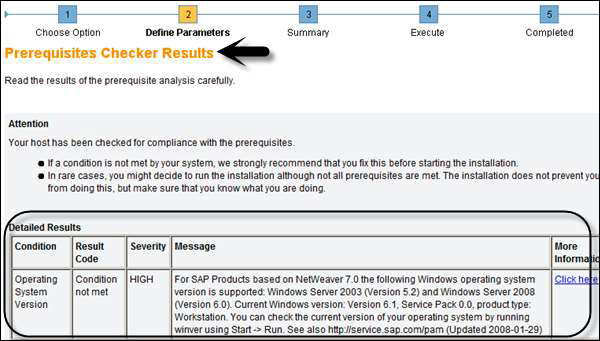
When you click next again, the wizard will take you to Parameter Summary tab. You can see the details of all the passwords (General Parameters, Master Password, Windows Domain) as shown in the following screenshot.
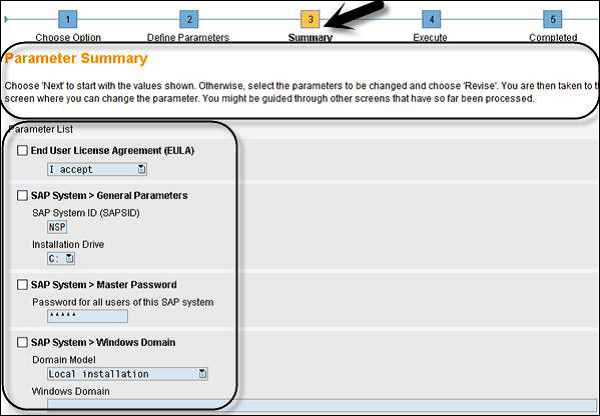
At the bottom, click the Next button. You will be moved to “Execute” tab of the installation Wizard. Here you can see phase-wise installation as shown in the following screenshot.
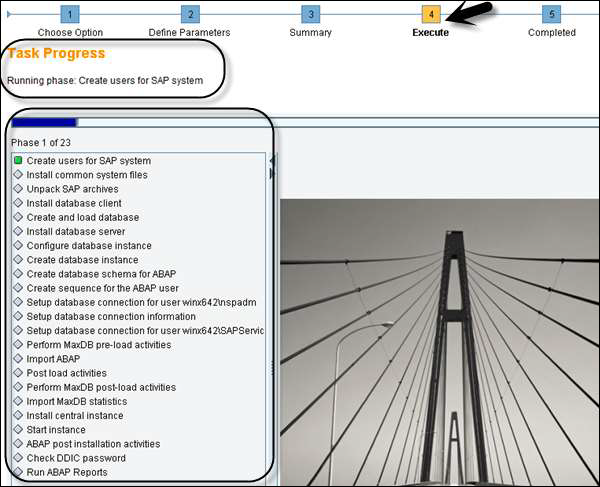
There are different errors you can face during this task progress. Some of them are −
- Database Error (Drivers issue)
- Import ABAP
- Post Installation Activities (Configuration issue)
Once the installation process is complete, you will see a confirmation message as shown in the following screenshot.

Passing Parameters for Installation
During the installation process, you have to pass different parameters, which are called as input user parameters. These parameters depend on the type of the installation mode. You can opt from the following installation options −
- Typical Mode
- Custom Mode
Typical Mode
When you select “Typical” mode, the installation wizard selects only the default values for the typical parameters and the installation run is shortened.
In Typical mode, you need to select the following input parameters −
- Master Password
- System ID
- Database connectivity parameters
- NetWeaver version 7.4 or higher you need to maintain an encryption key
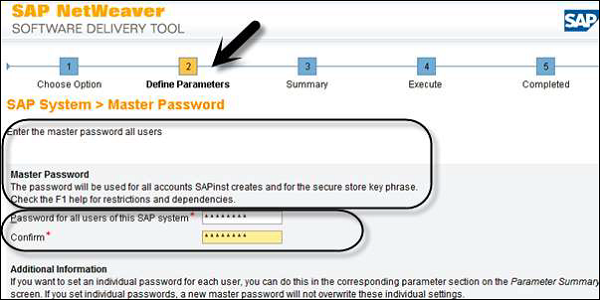
Custom Mode
When you select “Custom” mode during the installation, you have to select all the user input parameters. Once you define the parameters in the Installation wizard under step 2 → Next, you will be prompted to view the Parameter Summary.
In Summary step, you can again make changes to all the parameters.
Once the installation is done, you can’t change the parameter mode from Typical → Custom or Custom → Typical, so you should select as per the business requirement during the installation process.
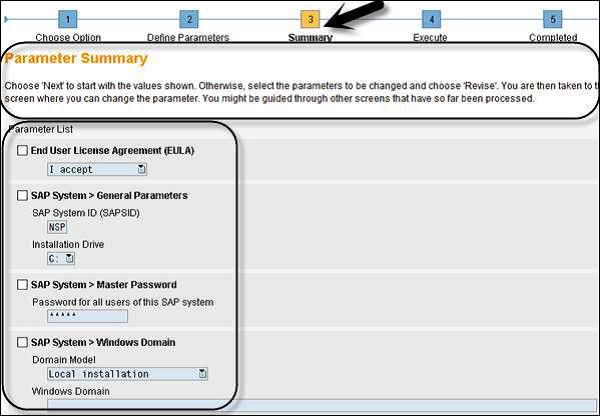
SAP NetWeaver - Transport Management
Transport Management System (TMS) is one of the key components in the SAP system and is used to control the new requests, to monitor the changes such as who has implemented the changes, as well as defining and configuring system landscape in SAP environment.
Transport Management System consists of 3 parts −
Change and Transport Organizer (CTO)
Transaction: SE01
This is used to manage, configure the changes in SAP repository and other objects. This provides a central environment for the development and configuration projects. (https://wiki.scn.sap.com)
Transport Management System
This is used to manage, control, and copy the development objects and for the customization to perform in SAP system landscape, using transport routes configured with RFC Connections. This includes exporting the objects from one SAP system and importing to the target system.
Tools
Tools are part of SAP Kernel and are used to manage R3trans and transport control program.
R3trans is known as SAP system transport, which is used to transport the objects between different SAP systems. It is called with transport control program (tp) or by using SAP upgrade utilities.
Transport control program is used to support data and object transport between different systems running on a different platform and also on a different database.
Configuring Transport Management
Transport management is one of the key components in the SAP system landscape.
Transport Domain Controller
This is used to manage all TMS configuration details. Any changes to configuration setting are distributed to all the systems. To set up the Domain controller, use Transaction: STMS
In case, SAP system doesn’t have a Domain Controller, you will be prompted to create a new one. Transport domain includes the following activities to be performed −
User creation TMSADM
RFC connection and request creation, TMSADM is used to login to the target system
DOMAIN.CFG file is created under usr/sap/trans/bin directory, which stores TMS configuration and is used by systems and domains for checking the existing configurations.
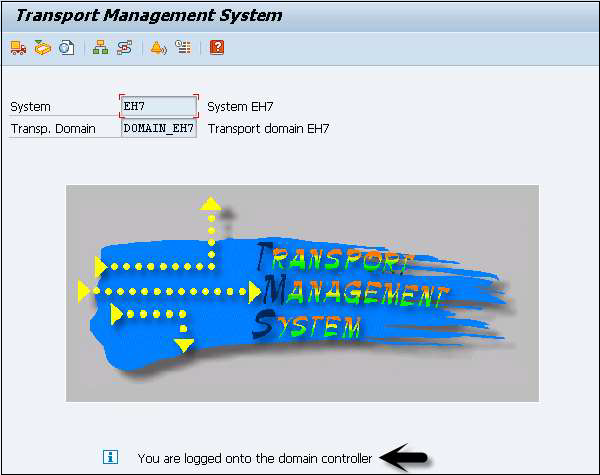
Adding a System to the Transport Domain
To add a system, log on to the SAP system that you want to add to the system. Use client 000 and start transaction STMS. If the system is not added, TMS will check the configuration file DOMAIN.CFG and will ask to join the domain. Click “Select the proposal” and save. The System will remain in the ‘Waiting’ status initially.
To complete the task → login to Domain Controller System → Transaction STMS → Go to Overview → Systems.
You can see the new system that will be available. Go to SAP System → Approve.


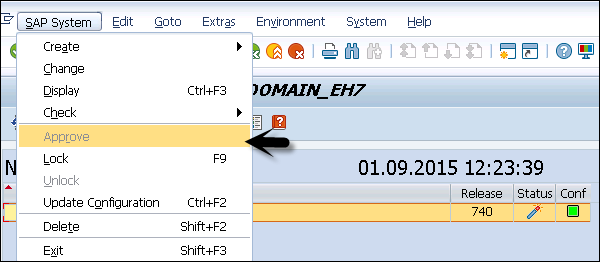
Managing Transport Routes
Transport routes are defined as routes that are defined by the SAP Administrator to transmit the changes between different SAP systems.
You can define two types of transport routes −
- Consolidation (From DEV to QAS) − Transport layers are used
- Delivery (From QAS to PRD) − Transport layers not required
Transport Request
Transport request contains the number of changes to be implemented in the development system. It consists of the type of change, purpose, change category, target system and other details.
Transport request are named in a standard format as − <SID>K<Number>
Example
SID represents System ID
K stands for fixed keyword/alphabet
Number can be anything from a range starting with 900001
There are two request types that can be created in the SAP system −
Workbench Request − This request type is used to contain the repository and cross-client customizing objects. Workbench requests are used to make changes in the ABAP workbench objects.
Customizing Request − This request type is used to contain objects that belong to client-specific customizing. These requests are created in the system automatically when a user customizes the setting and a target system is automatically assigned as per the transport layer.
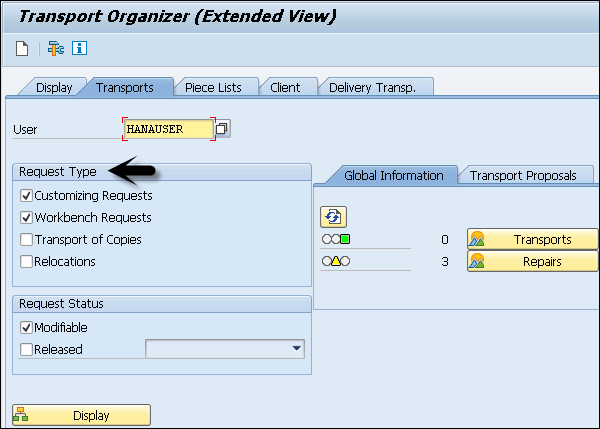
To create a Transport request, use Transaction SE01
Transport request can be created in two ways −
Automatic − It is created automatically.
Manual − You can also create a Transport request manually.
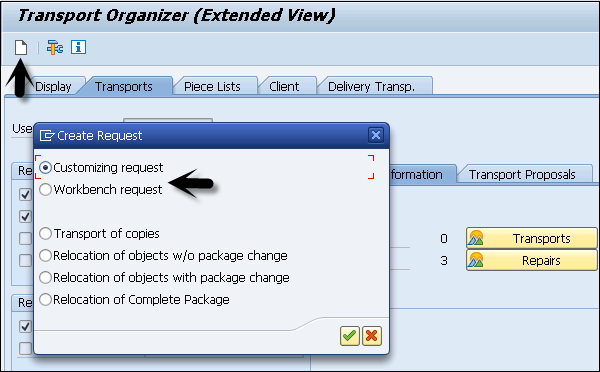
Import/Export of Objects in the Transport System
Once the Transport request is completed in the source system, you have to export the request from the source system and import it to the target system. To perform the import, you have to select the import queue.
Run the Transaction STMS → Import or you can go to the Overview tab at the top → Imports.
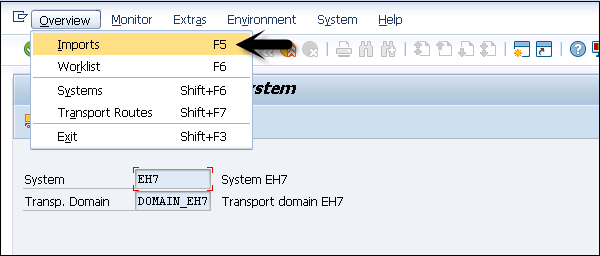
You can see a list of systems in the current domain, description, and the number of requests available in the Import Queue and the status.

Import Queue
This list contains Transport requests in the directory that are ready to import to the target system.

To add a request manually, you can go to Extras → Other Requests → Add. You should know the name of the Transport request.

Transport Request Logs
You can also check the logs once the transport request is completed. To check the logs, Transaction SE01 → Goto → Transport Logs.

Following two types of logs are available in the Transport Management System −
Transport Log − It keeps track of the transport log files which has been moved in a transport request.
Action Log − It includes the details of action logs that has been performed in a transport request. It includes exports, imports, etc.
Log Record Value
Following log record value exists in the Transport Management System −
0 − This value represents that export was successful.
4 − This value represents that a warning was issued and the objects were transported successfully.
8 − This represents that a warning was issued and at least one object could not be transported.
12 or higher − This value represents an error in the transport request and it is normally not resulted because of the objects in Transport Request. This occurs probably due to the system failure.
SAP NetWeaver - Managing Background Jobs
Background jobs are jobs in the SAP system that run in the background without affecting the normal operations in the system. Background jobs are used to reduce the manual effort and to automate the process. They can run in the background without any user input and can be scheduled to run when the system load is low.
Background jobs can be divided into three categories −
Class A (High Priority) − This is used for urgent or critical task and must be scheduled with class A priority job. Class A job reserves one or more background work processes.
Class B (Medium Priority) − These jobs are executed after the completion of Class A high priority jobs.
Class C (Low Priority − These job runs once class A and class B jobs are completed.
Transaction Code - SM36
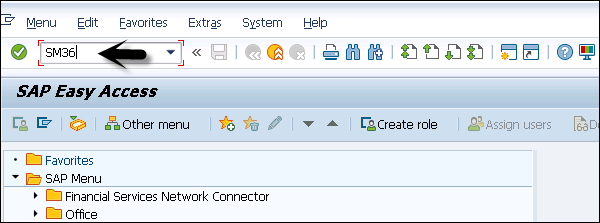
General Data
In general data, enter the following details to create a background job −
Enter the Job Name
Priority/Job Class
Select the Target server on which you want to execute the job. This is used for load balancing. You can define the target server on which you want to run the job.

Using Spool List Recipient, enter the email id if you want to get the results in email.
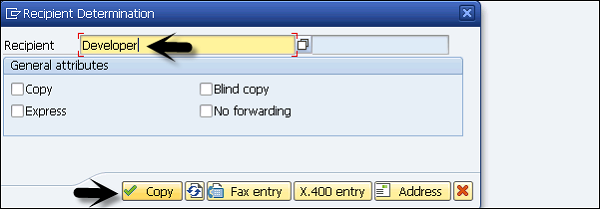
To define the steps for execution, go to Step tab. Enter the program name, Variant name in the field. If you have not created variant as per your requirement, then leave it blank. Click on the save button at the bottom.
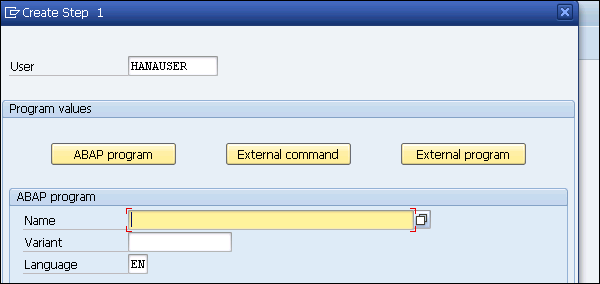

To pass the start condition, enter the start date, end date, frequency, etc. In case, the start condition is not specified, then the job will remain in the scheduled state and will not run. Various options can be used to define the start condition. To create a periodic job, select the box at the bottom.
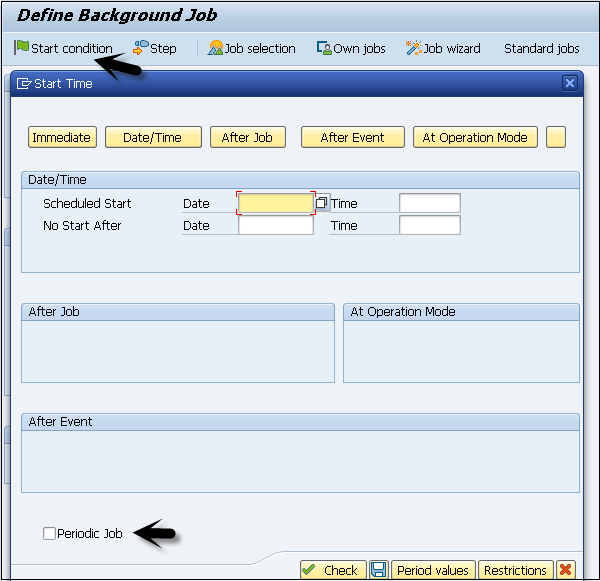
Once schedule is defined, click the Save button to save the job. You can define different Scheduling options −
Immediate − To immediately run the job.
Date/Time − You can add a date and time to run the job.
After Job − You can also schedule this job after a particular job is completed.
After Event − You can also add a schedule when a specific event is triggered.
At Operation Mode − You can also add a schedule in the operation mode.
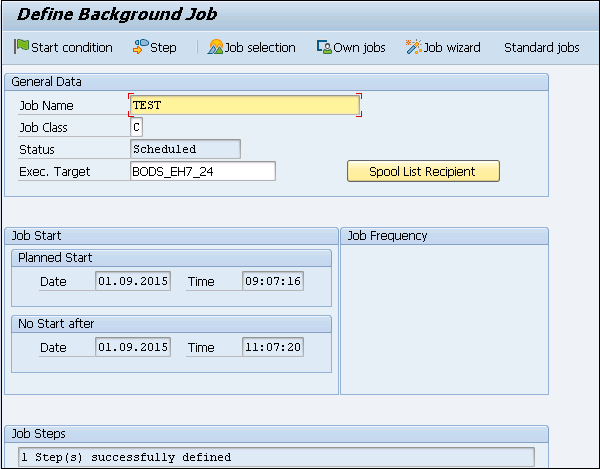
Unscheduling a Background Job
To un-schedule a job so that it doesn’t run in future, you have to release the job. To unschedule a job, use Transaction Code: SM37
Note − When a job is in the Active state, it can’t be unscheduled till it’s completed.
Step 1 − Enter the job name and the user name.
Step 2 − To un-schedule a job, select Released and Ready from the status tab.
Step 3 − Enter the Job start condition and Select Execute button at the top as shown in following screenshot.
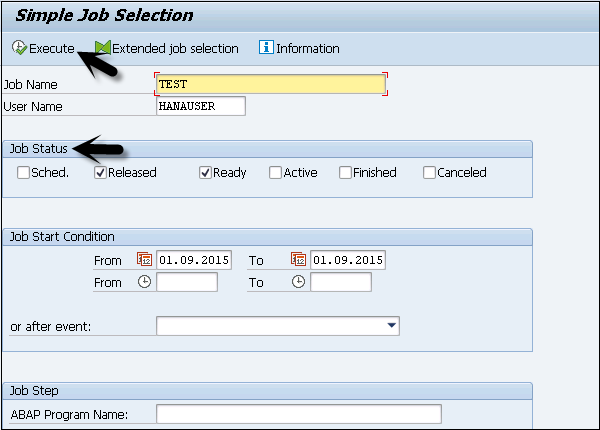
The following screenshot will confirm that job is released as well as other details of the job.
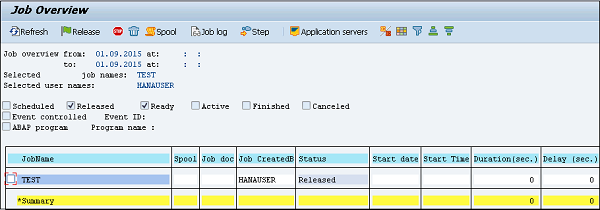
SAP NetWeaver - NW Business Client
SAP NetWeaver Business Client (NWBC) is a user interface to access all the applications from a single platform. You don’t need to open each application and you can work with each application without opening it in SAP logon or the Internet Explorer.
You can access NWBC in two ways −
NWBC for HTML
This can be opened using a URL and there is no need to install a client tool in this case.
URL format − http://applicationservername.com:8070/nwbc/~launch/?sapclient=800&sap-language=EN
You have to enter the details in the URL to login to NWBC. The following information is required: System, Client, User, Password, and Language as shown in the following screenshot.
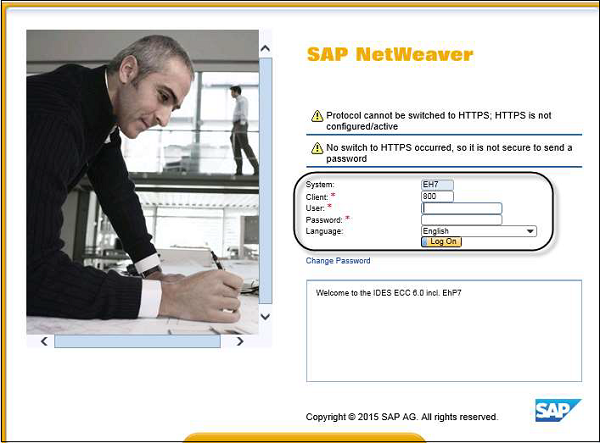
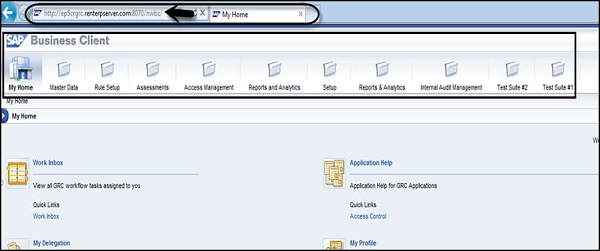
NWBC for Desktop Application
In this case, you need to install NWBC desktop tool and you have to add the URL and Application server details.

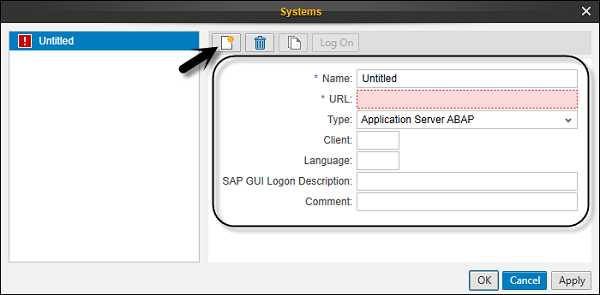
SAP NWBC supports Single Sign On and hence it will be a very useful tool for business users as well as for developers to perform all the necessary action from a single platform as there is no need to login at multiple places to access different applications.
Note − Users can use SAP NetWeaver Business Client and SAP Front End GUI client to access SAP systems. The use of both depends on the requirement. If the user accesses only the SAP system and no web-based applications are used, SAP GUI is preferred.
When the user has both SAP system and web-based application, it is recommended to use NetWeaver Business Client.
Key Difference between SAP GUI and NWBC
The main difference between NWBC and SAP GUI is the way you can access Web Dynpro (WD) application. Using SAP GUI, when you execute WD application, it opens in a browser whereas on NWBC it opens within the GUI just like a normal Dynpro transaction if that application is added to your role.
Note that SAP NW Business Client works on a role-based access. That is, when you log in to a particular system using NWBC, you will see only those transactions in the roles assigned to you and the tabs you can see on the home page is defined as per the role assigned.
NWBC Release
There are 3 versions that has been released for NetWeaver Business Client: NWBC 3.0, NWBC 3.5, and NWBC 4.0
To use NetWeaver Business Client 4.0, you also should have the latest version SAP GUI installed, i.e. SAP GUI 7.4.
NetWeaver Business Client navigation is divided into 4 parts as shown in the following screenshot −
- Navigation Panel on the left side
- Navigation Tab at the top
- Canvas work area
- Quick Launch bar above the navigation tab
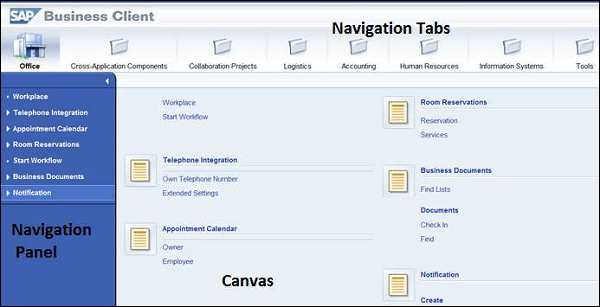
In the Launchpad, you can perform advanced Search that doesn’t require the developers and the users to remember the full transaction code. You can simply start typing the first letter and it will provide you with suggestions.
SAP NetWeaver - Service Configuration
etWeaver Business Client uses HTTP to access an ABAP server. Hence, it is important to configure at least one port and it should be active.To configure HTTP service, use Transaction SMICM

To display the services configured in the back-end system, click on Goto → Services

If the HTTP or HTTPS service does not yet exist or you would like to make changes, you can create or edit a service, following the path - Service → Create or Service → Change.
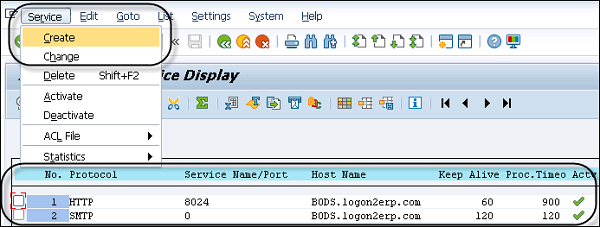
To activate/deactivate a service, select the service and click Service → Activate.
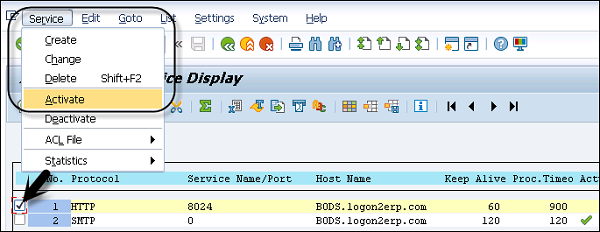
Activate Services in ICF
Using Internet Communication Framework, you can communicate your SAP system using standard protocols. To be able to use NWBC for your system, you need to activate SICF service on your system using the SICF transaction which is /sap/bc/nwbc and its components under it.
Step 1 − To activate the service, call Transaction: SICF
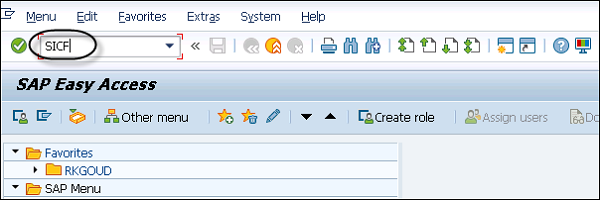
Step 2 − Set the Hierarchy Type to SERVICE and click Execute (F8).
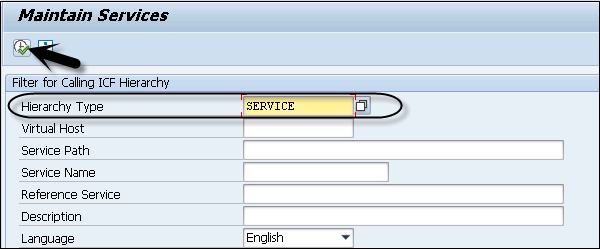
Step 3 − Expand the nodes under the default_host.
Step 4 − The cockpit subnode for the Business Client can be accessed by navigating down to the following service tree: default_host/sap/bc/nwbc
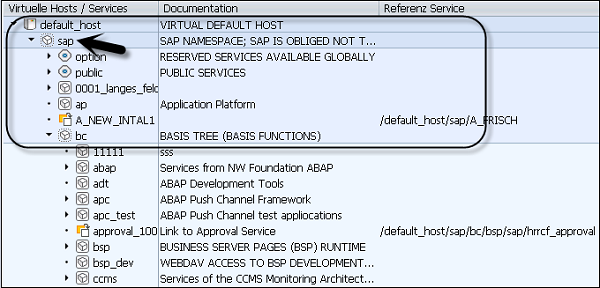
Step 5 − Select the relevant service node(s) and choose Service/Host → Activate.
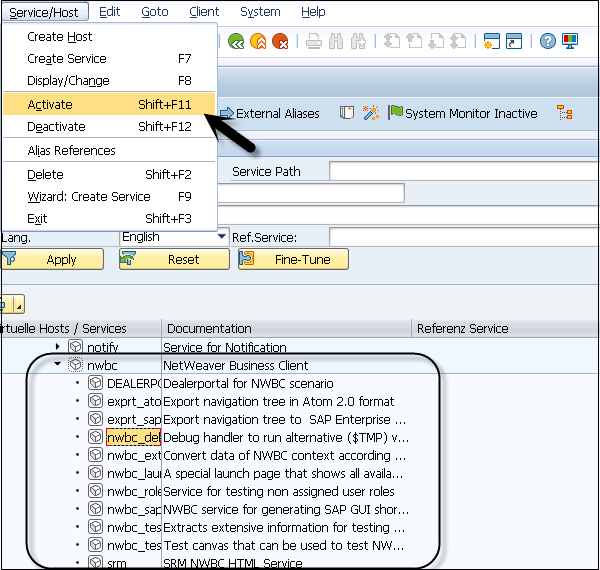
Step 6 − Select any service and click deactivate. You will be prompted to confirm the deactivation.
Step 7 − Go to Info tab as shown in the following screenshot, you can see the results of deactivation. Click Yes for the corresponding services to be deactivated.
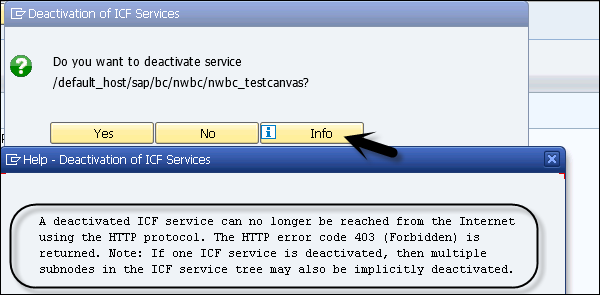
SAP NetWeaver - Business Client Installation
NetWeaver Business Client is available for Windows operating system and ensures the smooth running of Business client.
Hardware requirement includes at least 1 GB memory and the requirement of memory depends on the number of open session tabs and the number of windows.
SAP recommends minimum screen size of 1024*768 and VGA monitoring. All the hardware requirements are same as of SAP GUI front-end installation.
To install NWBC desktop application, you need the setup of the tool.
Step 1 − Run the setup file by double-clicking on it and the installation wizard will open. The wizard will help you configure SAP Product installation → Next.
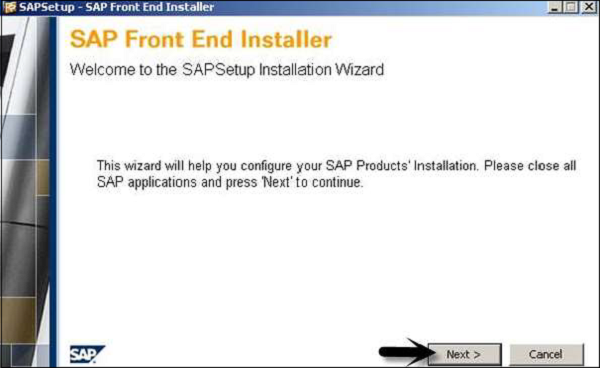
Step 2 − In the next window as shown in the following screenshot, you have to make the product selection. Select SAP NetWeaver Business Client and click the Next button. You should have enough memory on your disk drive to meet the Memory Space Requirements for the installation.
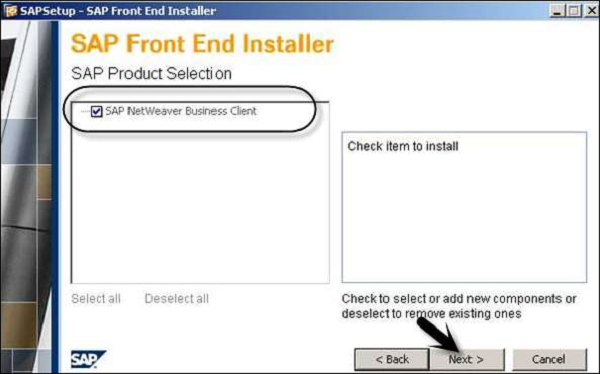
Step 3 − Select the Next button and the installation process will start. During the installation process, you will be informed about the installation progress.
Step 4 − To complete the setup, click the Finish button as shown in the following screenshot.
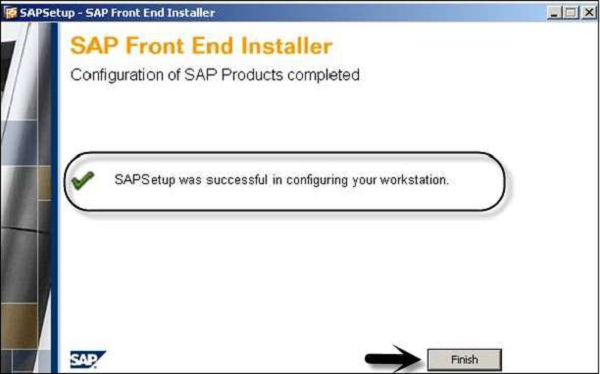
NWBC Transaction & Navigation
There are different system transaction codes provided, that you can use to access and manage NetWeaver Business Client in the ABAP system. Use transaction code, Transaction: NWBC
When you run this transaction in ABAP system, this will start the “launch URL” in the browser and a separate browser instance will start.

In case, your HTTP service is not configured/activated, you will get the following message when you run Transaction: NWBC

To resolve this, you have to run Transaction SMICM. Click Go To → Services. Select HTTP service, Service → Activate.
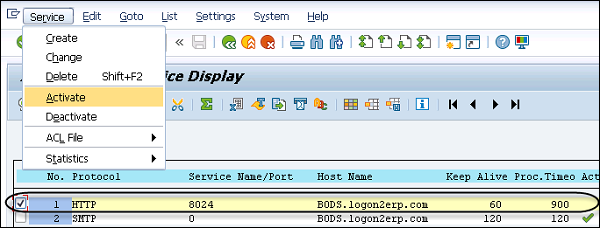
When you run NWBC transaction in ABAP system, it shows a list of all cockpits on the system and the list of associated roles.
The first icon or the link with the leading slash will open NWBC for HTML.
The second icon or the link without the leading slash will open NWBC desktop tool.

Note − Using transaction NWBC, class CL_GUI_HTML_VIEWER always starts the URL in the browser – Microsoft Internet Explorer, even if another browser is defined as your default browser on the system.
This is due to the reason that class contains additional logic to inject authentication information from the running SAP GUI session into the Internet Explorer (IE) instance when started. Hence, the client will be open in Internet Explorer browser with the same user name.
SAP Applications based on NW
SAP NetWeaver is known as open technology software component that provides you a platform to run critical business applications and integration between people, processes, and information. It allows the composition, provisioning, and management of SAP and non-SAP applications across a heterogeneous software environment.
The following table defines the main use cases of SAP NetWeaver and its key area −
| S.NO | Use Case & Description |
|---|---|
| 1 | Data Warehousing SAP BW |
| 2 | Building Integration scenarios SAP Process Integration PI |
| 3 | Mobilizing Business Processes SAP NetWeaver Mobile |
| 4 | Building Composite Applications SAP Composition Environment |
| 5 | Integration with SAP Enterprise Portal SAP Enterprise Portal |
| 6 | Application Development ABAP ABAP Development on NetWeaver Application Server ABAP |
SAP NetWeaver BW
SAP Business Intelligence (BI) means analyzing and reporting of data from different heterogeneous data sources. SAP Business Warehouse (BW) integrates data from different sources, transforms and consolidates the data, performs data cleansing, and storing of data as well. It also includes data modeling, administration, and staging area.
The data in SAP BW is managed with the help of a centralized tool known as SAP BI Administration Workbench. The BI platform provides infrastructure, which include OLAP Processor, Metadata Repository, Process designer, and other functions.
The Business Explorer (BEx) is a reporting and analysis tool that supports query, analysis and reporting functions in BI. Using BEx, you can analyze the historical and current data to different degree of analysis.
SAP BW is known as an open and standard tool, which allows you to extract the data from different systems and then sends it to the BI system. It also evaluates the data with different reporting tools and you can distribute this to other systems.
The following diagram shows an open, broad and standard-based Architecture of Business Intelligence.
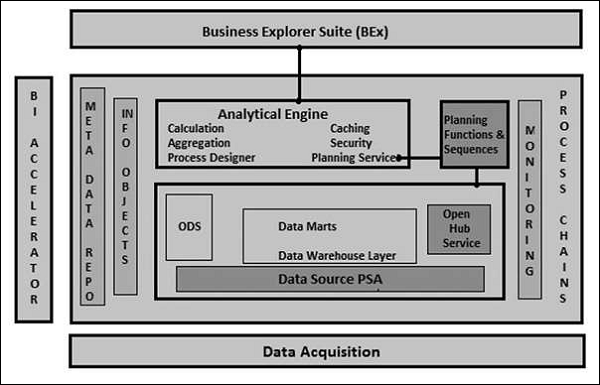
SAP Process Integration
SAP Process Integration (PI) is a part of the SAP NetWeaver platform. It is called SAP NetWeaver Exchange Infrastructure (XI) in NetWeaver 7.0 ehp2 and older versions. SAP NetWeaver Process Integration is a part of the NetWeaver software component and is used for exchange of information in the company’s internal system or with external parties.
SAP PI/XI enables you to set up cross-system communication and integration, and allows you to connect SAP and non-SAP systems based on different programming languages like Java and SAP ABAP. It provides an open source environment that is necessary in complex system landscape for the integration of systems and for communication.
SAP Process Integration is a middleware to allow seamless integration between SAP and non-SAP application in a company or with systems outside the company.
SAP PI architecture consists of multiple components which are used at design time, configuration time, and runtime. In SAP PI, the sender system is known as the source and the receiver is called the target system and the architecture is known as Hub and Spoke structure. The Spoke is used to connect with external systems and the Hub is used to exchange messages.
A SAP PI system is divided into the following components −
- Integration Server
- Integration Builder
- System Landscape Directory SLD
- Configuration and Monitoring
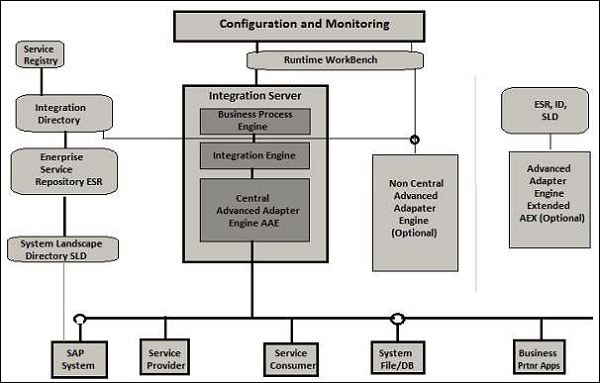
SAP NetWeaver Mobile
SAP NetWeaver mobile is a solution which is used to develop mobile solution for SAP Business Suite. You can use different tools to deploy and operate mobile applications for occasionally and always connected mobile devices.
There are two possible scenarios for SAP NetWeaver mobile −
Occasionally Connected
In occasionally connected SAP NetWeaver mobile scenario, a mobile device contains a mobile client and a web server, database layer, and business logic.
In this scenario, use can work offline and doesn’t wait for network connectivity to middleware to work on any critical tasks assigned to them. NetWeaver mobile device also contains tool for data synchronization and data replication to make data available to the back-end system.
Always Connected
In always connected scenario, to manage business operations, the mobile device is always connected to the middleware. Mobile applications are available on the central server and there is no mobile client. The users have to connect to the server to access these applications.
Applications are developed and deployed on the central server and it is rendered differently as per different mobile devices.
In both the mobile scenarios, SAP NetWeaver Mobile acts as the middleware for enterprise mobility. Following functions are provided using this middleware −
- Messaging and Network Monitoring
- Device Management
- Data distribution
- Enterprise Identity
- Security
Application Development ABAP
ABAP stands for Advanced Business Application Programming, a 4GL (4th generation) language. Currently it is positioned, along with Java, as the main language for SAP application server programming.
Web Dynpro is a standard SAP UI technology that allows you to develop web applications using graphical tools and development environment integrated with ABAP workbench. The use of graphical tools reduces the implementation effort and you can better reuse and maintain the components in ABAP workbench.
To access Web Dynpro runtime environment and graphical tools in ABAP workbench, you can use Transaction code - SE80.
Both these solutions are developed on NetWeaver platform and provides application and web-developed environment to users.
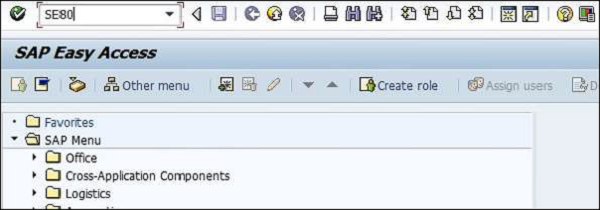
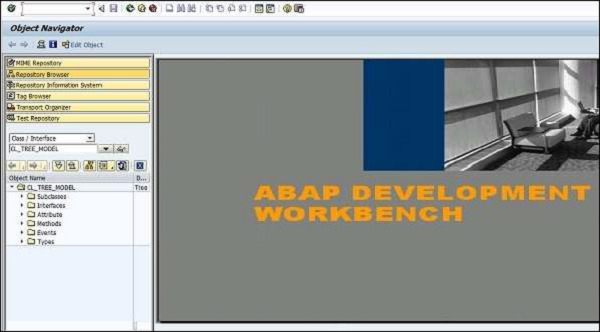
Web Dynpro is an ABAP environment for web development and is based on the Model View Controller (MVC) concept of UI programming. It is available for both Java and ABAP as per the platform, and supports similar functions.
Web Dynpro has the following features −
- Separation of display and business logic
- Easy change in the layout with the use of graphical tools
- No platform dependency of interfaces
Following are the key concepts as part of Web Dynpro architecture −
Metadata
Web Dynpro provides you with an environment for the development of web-based applications and you can use graphical tools to define Web Dynpro application in the form of metadata in application development. You can also define your own events; however, event handling should be defined in a separate code and that has to be executed when an event is triggered.
The user interface in Web Dynpro application consists of small elements defined by using Web Dynpro tools. You can also change or enhance the user interface by changing these elements at run time or integrate the elements again.
Graphical Tools
There are a wide range of graphical Web Dynpro tools that you can use to generate webbased applications. You don’t need to create source code for this. Following are the key features of graphical tools in Web Dynpro application −
- Define properties of user interface elements
- Data flow
- User interface layout
For all these properties, you can use graphical tools without creating a source code.
Business and Application Logic
Web Dynpro allows you to run your application on the front-end, and the back-end system can be accessed using the service locally or via a remote connection. Your user interface is maintained in Dynpro application and a persistent logic runs in the back-end system.
You can connect Web Dynpro application to the back-end system using an adaptive RFC service or by calling a web service.
MVC Programming Model
Web Dynpro applications are based on MVC model −
Model − This allows access to back-end data in a Web Dynpro application.
View − This is used to ensure the representation of data in a web browser.
Controller − This is used to control the communication between Model and View where it takes the input from the users and gets the processes data from the model and displays the data in the browser.
SAP NetWeaver - Portal
SAP NetWeaver portal is one of the key components in NetWeaver architecture and provides a single point of access to the organization’s applications. Customers, partners, and the employees of the organization can use Enterprise Portal as a single point of access to the organization’s services and information needed for performing their day-to-day task.
SAP NetWeaver Portal allows the following types of authentication to the users −
- Username and password
- SAP Logon Tickets
- X.509 certificate using Secure Socket Layer (SSL)
- Client Certificate
- Assertion Ticket
SAP NetWeaver portal provides two types of usage −
Application Portal EPC
This is applicable when full enterprise portal capabilities are not required. It is also known as EP Core. It consists of Portal and Universal Worklist (UWL).
Portal provides single access point to SAP and non-SAP information sources, organization applications, database and services.
The user can access the portal from mobile devices like smartphones, tablets, as well as from desktop and laptops. Portal allows the users - employees, customers, partners, and suppliers - to manage role-based access in accessing the information, specific to their daily work tasks.
Universal Worklist allows the business users to manage, operate, and delegate daily work items. Work items can be generated using automated business processes
Using UWL, it collects work items from multiple provider systems in one list for one-stop access.
NetWeaver Enterprise Portal
Enterprise Portal includes Knowledge management and Collaboration capabilities and is based on EP Core.
Portal Navigation
When you run NetWeaver Portal, it provides all key objects of your organization with a role-based secure access to their day-to-day work-related information. All the stakeholders - customers, partners, suppliers and vendors - can access SAP applications, third party applications, desktop applications, documents, databases, and other services.
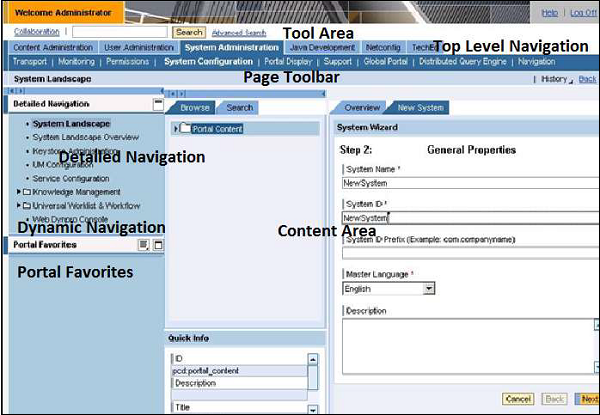
NetWeaver portal framework contains all the required components and functions on each page that the user can navigate.
Top Level Navigation − To manage the user and system administration tasks and development activities.
Detailed Navigation − System landscape, all added system and Landscape Management, and Service Configuration. Knowledge Management and Universal Work List navigation.
Search Field with Tool Area − To perform a Search in Portal content and advance search options.
Dynamic Navigation
Portal Favorites − You have favorites link to be directly accessed from the home page.
Content Area − Whatever content is selected from the detailed level navigation, that content is displayed in the Content Tool bar.
Page Toolbar − This toolbar is different for each page and varies as per selection and content-area content.
SAP NetWeaver - Create a System
You can create a new system under NetWeaver portal and also add an Alias of the system.
Step 1 − To create a system, you have to login to the portal as an Administrator.
Step 2 − In the top level navigation bar, go to System Administration → System Configuration → System Landscape, as shown in the following screenshot.

Step 3 − Next, go to Portal Content. Right-click Portal Content and select New System as shown in the following screenshot.
Step 4 − Select JDBC System, and click Next.
Step 5 − Enter the System Name and System ID properties as New System → Next → Finish.
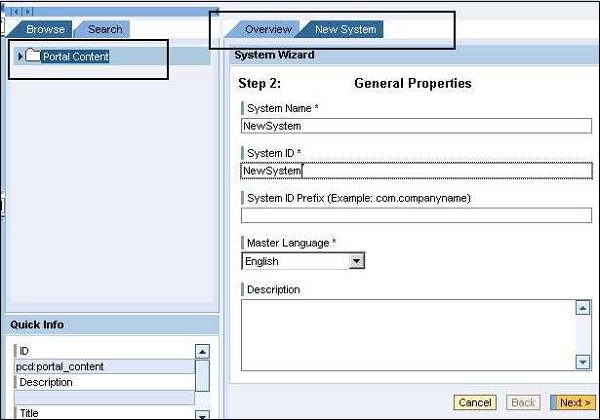
Enterprise Portal Roles and Group
All the user and roles tasks of Enterprise portal can be performed using User Management Engine (UME). UME is integrated to SAP NetWeaver Application Server. In UME, you define UME actions to apply authorizations. UME actions are JAVA permissions to define the user roles and they can be further assigned to Portal roles.
User Management Engine performs user authorization to ensure that users have the correct UME actions assigned to them before providing access to iViews and functions in Enterprise Portal.
For each portal role, there is UME action defined in the User Management Engine. Following table lists down all the key portal roles and corresponding UME actions.
| Key Portal Roles | UME Actions |
|---|---|
| Delegated User Administrator | UME.Manage_Users UME.Manage_Role_Assignment |
| Every User Core Role | UME.Manage_My_Profile |
| Standard User Role | UME.Manage_My_Profile |
| Super Administrator | UME.AclSuperUser UME.Manage_All |
| System Admin | UME.System_Admin |
| User Administrator | UME.Manage_All |
Following UME actions are defined only for Enterprise Portal roles −
- UME.AclSuperUser
- UME.Manage_Role_Assignments
- UME.Remote_Producer_Read_Access
- UME.Remote_Producer_Write_Access
Comparison between UME & Portal Roles
In NetWeaver portal, both UME roles and Portal roles can be managed by Portal administrators. UME roles contain JAVA actions; however, portal role contains access to iViews, folders, and systems.
Following table lists the key differences between UME and Portal Roles −
| Portal Roles | UME Roles |
|---|---|
| Used to manage the portal content - iViews, work sets, folders, etc. | UME actions are sets of Java permissions. |
| This is used to define how the content is grouped together and how it is displayed in the portal. By assigning a portal role, you define which content a user sees in the portal. | This is used to define the authorizations that a user has to run applications on the J2EE engine. |
| When you assign a portal role to a user or group, they get end-user permission on the role. | This provides access to applications on the J2EE engine. |
| They are created in the Role editor of Portal Content Studio. | They are created using Identity Management. |
Create a Role and Add iViews to Role
Step 1 − To create a role, navigate to Content Administration → Portal Content.
Step 2 − Right-click a folder of your choice and select New → Role.

Step 3 − To start with, create a role and name it OBNRole.
Step 4 − To start with, create a role and name it OBNRole.

Step 5 − Go to User Administration tab → Roles as shown in the following screenshot.
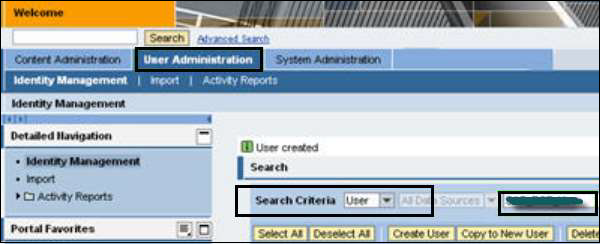
Step 6 − Find the OBNRole created in the previous step and add to it the Administrator user/other user using the Assigned role tab as shown in the following screenshot.

SAP NetWeaver - Knowledge Management
SAP NetWeaver Knowledge Management (KM) component organizes unstructured information from different data sources into a structured format and makes it accessible to all users. The information from various data sources exist in the form of notepad documents, PPTs, and HTML formats. Information from different sources can be integrated using different functions.
Key Features of SAP Enterprise Knowledge Management
Following are the key features of SAP Knowledge Management capability −
Unified access across multiple document stores
- Unified API for any repository
- Broad set of connectors can be extended by partners
- Integrated into the SAP Enterprise Portal
Full set of content management services
Browsing, Search, Check-In and Check-Out, subscription based to Knowledge articles.
Full set of search & classification services
- Indexing, searching
- Automatic classification
- Text mining
Search in
- Full text
- Attributes
Different search modes
- Exact
- Linguistic: use stem of query term for searching
- Fuzzy search error tolerant
- Wildcard search, using “*” or using”?”
- Phrase search for complex expressions
- Boolean operators
- Highlighting / HTML conversion / links to maintained keywords
- Content snippets
- Federated search (usage of other search engine indices)
Text Mining
- Search for similar documents
- Suggestion of alternative search terms
- Automatic classification of documents into categories
Creating and uploading document to the Knowledge Center
In NetWeaver Knowledge Management, documents can be created and published to Knowledge management folder. These documents can be accessed by all the users and each user can create a document in Portal. It can be published to Knowledge Management folder.
SAP NetWeaver - KM Administration
Various configuration/administration functions are performed in the respective areas of Knowledge Management in Enterprise Portal.
Initial Configuration
To make KM run, you need to perform basic configuration immediately after the installation process. These activities are mandatory to use Knowledge Management features.
- Install Search and Classification Engine (TREX)
- Template-based Basic Configuration
- Manual Configuration
System Administration
You have to perform various administrative tasks related to Knowledge Management Portal. These tasks can be performed using the Administration tab in Enterprise Portal.
- System Configuration
- Monitoring, Logging, and Tracing
You can find the tools for these tasks under the System Administration tab in the top-level navigation pane of the portal as shown in following screenshot.
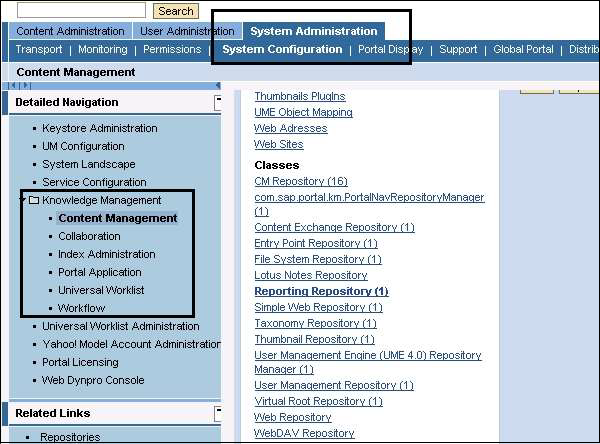
Content Administration
Content administration deals with managing different types of Knowledge Management content. Portal content and KM content are managed using Content Administration role of SAP Enterprise Portals.
Types of content in KM −
Portal Content − This includes iViews as mentioned in the previous chapter which is used to access KM functions and other Portal content directory.
KM Content − These objects are managed in the knowledge management repositories.
Add Reports to KM Repository Manager
When you deploy a report within PAR file structure, you need to assign the report to the Repository Manager.
Step 1 − Navigate to System Administration → System Configuration tab in the top-level detailed navigation bar.

Step 2 − On the left side, in the detailed navigation bar go to Knowledge Management → Content Management → Repository Manager → Reporting Repository.
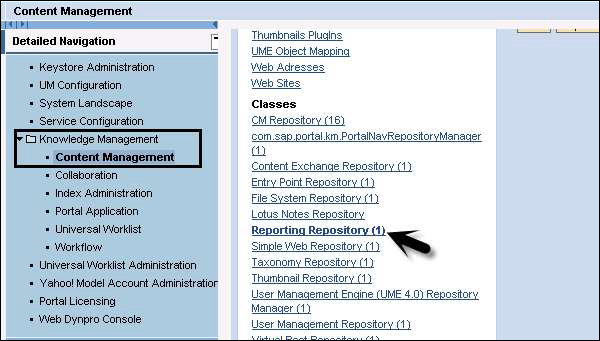
Step 3 − Next is to select the standard reporting repository manager for editing and add the Simple Report to the active reports list. Once you add the custom report to manager, you have to save the changes.
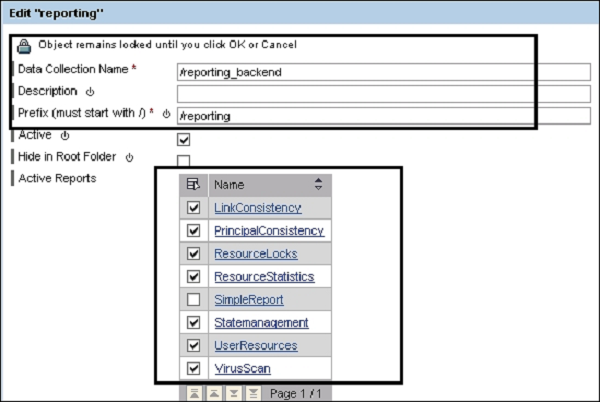
Step 4 − Go to the Content Manager Role, you can see that the new report is available for schedule. This report can be run by the Content Manager.
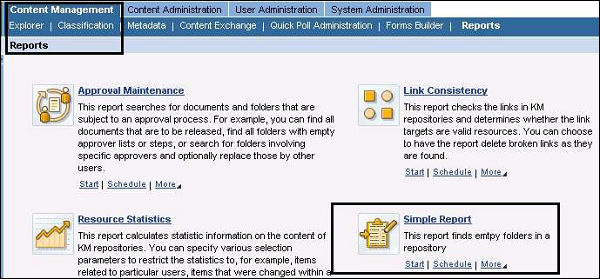
SAP NetWeaver - Developer Studio
NetWeaver Developer Studio is SAP Eclipse-based environment to develop Java business applications. Using Developer Studio, you can develop applications based on different programming models − Web Dynpro and Java EE.
The latest release of Developer Studio comes with NetWeaver Composite Environment 7.1. Following are the key capabilities of NetWeaver Developer Studio −
You can deliver a robust, fully-integrated development environment, matched in particular for extensive Java projects and for large teams of developers. Using Developer Studio provides a highly productive environment, which covers the whole life cycle for Java projects.
With the help of Developer Studio, it reduces the complexity of solutions and increases the reusability by providing close support for SAPu2019s development component model.
With highly flexible development process, you can use Developer Studio to be used as a local development environment. You can build and edit all sources offline, deployed and tested on a locally installed server.
Developer Studio provides a complete set of development tools for all aspects of Java business development − user interfaces, e-business logic, and Java persistence.
Developer Studio provides wizards and a variety of graphical editing tools that enhance the productivity and reduce the development cost.
Create a Web Project in Developer Studio
Step 1 − To create a project in NetWeaver Developer Studio, open the Developer Studio.
Step 2 − To open JAVA Perspective, go to Windows → Open Perspective → Other → Java EE.
Step 3 − Select File → New → Project and this will open the New Project window. Select the project type.

Step 4 − Once you click Next, you have to enter the Project name and select the Target runtime and Configurations.
Step 5 − Click the Finish button.
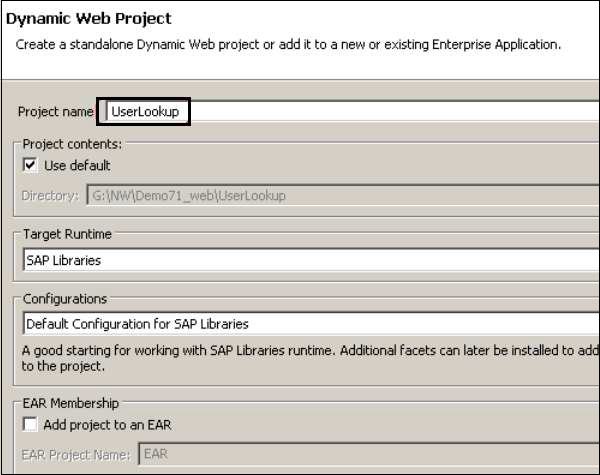
Step 6 − When you click Finish, this will open the project in NetWeaver Developer Studio as shown in the following screenshot.
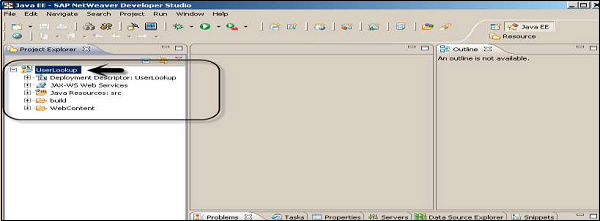
You can perform the following common J2EE application development −
- Create J2EE components application development.
- Collect different components into a single unit that can be deployed on an Application Server like NetWeaver.
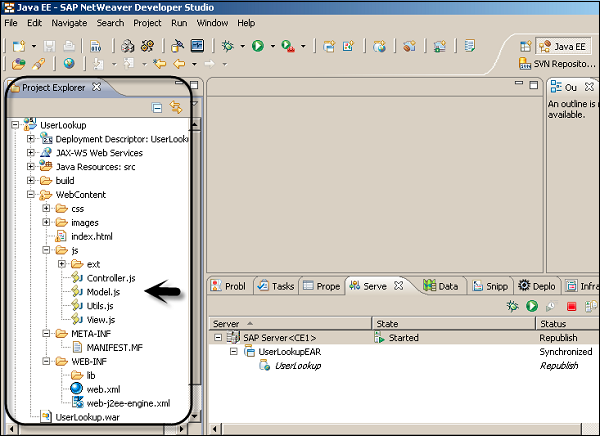
SAP NetWeaver - Web Content
Web Content generated by the business users can be managed using the Web Page composer tool that allows business users to manage most of WCM tasks and creation of portal pages that can combine business applications with user-generated web and static content. Using the Web Page composer, you can blend business applications and user generated content.
Web Page Composer supports the professionals to create interactive portal pages. End users can easily access web content and applications in the portal.
Following are the structural components of Web Page Composer page.
Navigation − WPC areas are integrated into the role-based navigation structure.
Favorites − The end user can save their favorite pages for quicker access.
Search − Search results include contextual information such as the relevant page and role.
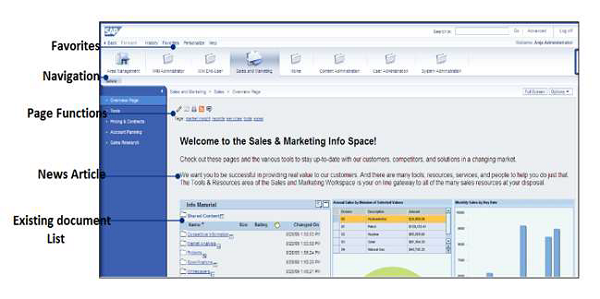
Add an Article Using Web Page Composer
Step 1 − Navigate to Area Management → Content Editor → Article tab → Content
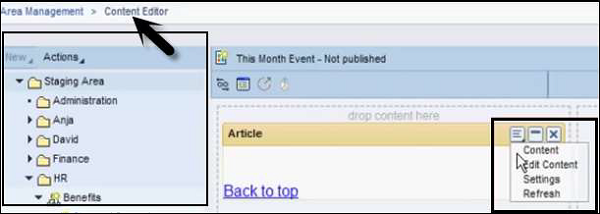
This opens the Content Editor window.
Step 2 − Add the following details to post an article in Enterprise Portal −
- Title of the Content
- Author
- Select Image
- Abstract
- Headers
- Paragraphs
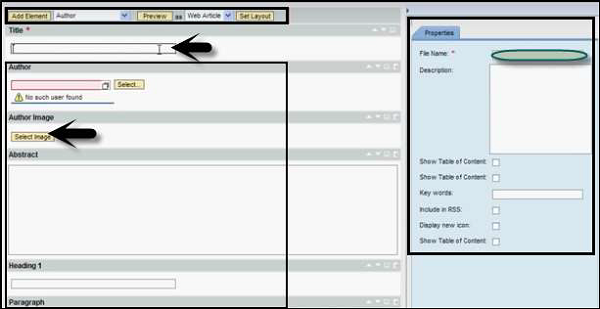
Step 3 − To save and publish this article, click the save button.
Step 4 − To view this article, go to Article tab and click the Refresh button.
Step 5 − Go to Page content on the right side and mention how you want to publish this content on Enterprise Portal. Following are the available options −
- Article
- Banner
- Link List
- Paragraph
- RSS Link List
- Teaser
- URL View
Step 6 − To preview the published content, go to Article Editor → Preview button at the top.
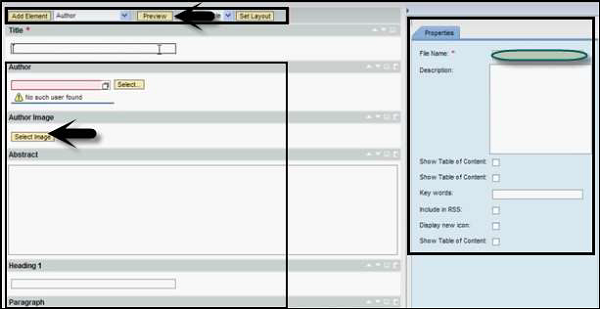
Process Integration Options
SAP Process Integration (SAP PI) is a part of the SAP NetWeaver platform. It is called SAP NetWeaver Exchange Infrastructure XI in NetWeaver 7.0 ehp2 and older versions. SAP NetWeaver Process Integration is a part of the NetWeaver software component and is used for exchange of information in the organization’s internal system or with external parties.
SAP PI/XI enables you to set up a cross-system communication and integration, and allows you to connect SAP and non-SAP systems based on different programming languages, like Java and SAP ABAP. It provides an open source environment that is necessary in complex system landscape for the integration of systems and for communication.
SAP Process Integration is a middleware to allow seamless integration between SAP and non-SAP application in an organization or with systems outside the organization.
Why Do We Need SAP PI?
In an organization, SAP ERP doesn’t contain a single system but consists of a number of integrated systems, like SAP CRM, FICO, EWM, etc. SAP PI provides a platform as a single point of integration for all systems without touching the complex legacy system for all data and information exchange.
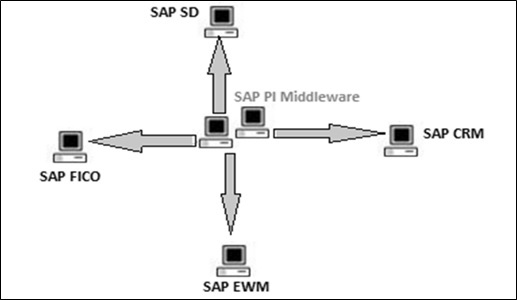
Following are the key capabilities provided by SAP Process Integration −
Connectivity
Using SAP PI, you can connect different applications and systems that have different technical ways of communication. SAP PI provides you with a variety of adapters that allow you to connect applications based on different protocols like HTTPS or Remote Function Call (RFC).
Routing
Routing defines the rules for flow of messages between the different systems at runtime.
Mapping
SAP PI is used to connect different applications or systems in a distributed environment that can be set up between different organization. Hence, there is a possibility that the structure of data exchange between two components differs from each other.

SAP NetWeaver PI Installation Options
When you run a scenario in SAP PI, the communication and processing capabilities depend on runtime engines that are installed with the installation of SAP PI. You can install one or more runtime engines on a host system. SAP PI provides the following two installation options −
Type 1 - Dual Usage Type
This installation is based on ABAP and Java and provides tools for designing and configuring integration content as well as the following runtime engines −
- Integration Engine
- Business Process Engine
- Advanced Adapter Engine
Type 2 - Advanced Adapter Engine Extended (AEX)
This installation is based on Java and provides tools for designing and configuring integration content and contains AEX as runtime engine.
SAP NetWeaver PI Architecture
SAP PI architecture consists of multiple components which are used at design time, configuration time, and runtime. In SAP PI, the sender system is known as the source and the receiver is called the target system. The architecture is known as Hub and Spoke structure. The Spoke is used to connect with external systems, while the Hub is used to exchange messages.
A SAP PI system is divided into the following components −
- Integration Server
- Integration Builder
- System Landscape Directory (SLD)
- Configuration and Monitoring
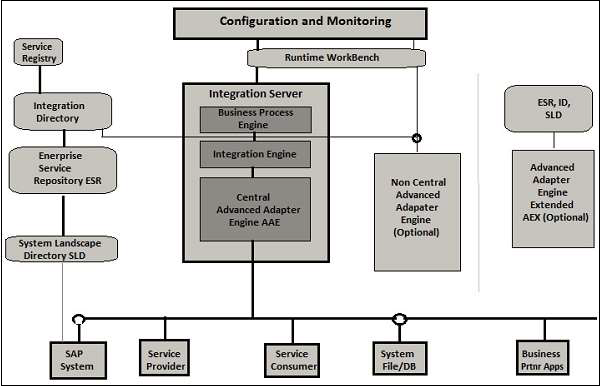
SAP NetWeaver - Gateway
SAP NetWeaver Gateway is used to set up a connection between SAP business suite, target clients, platforms, and framework. It offers development and generation tools to create OData services with different client development tools.
SAP NetWeaver gateway provides an easier way for the consumption on business logic and the content for SAP back-end system on web applications. It also reduces the complexity to access SAP data and provides easy interfaces to decrease the development time.
SAP NetWeaver Gateway: Capabilities and Key Benefits
SAP NetWeaver Gateway is a technology that provides a simple way to connect devices, environments, and platforms to SAP software based on market standards.
Non-disruptive, any SAP business suite.
Easy to develop simple APIs and does not require any tool knowledge.
Based on REST, ATOM/OData. It allows connectivity to SAP applications using any programming language or model, without the need for SAP knowledge, by leveraging REST services and OData/ATOM protocols.
It provides plug-ins for well-known IDEs such as Eclipse, Visual Studio 2010 and XCode.
Gateway Installation / Deployment Options
There are two different deployment options available to deploy SAP NetWeaver −
Central Hub Deployment of SAP NetWeaver Gateway
In this option, Gateway server functionalities are used on one dedicated server, the hub system. As against the first option, service deployment takes place on the Hub system.
This option is used if either no development must be performed on the back-end system or in case of releases prior to 7.40. or if it is not allowed to deploy the Add-On IW_BEP in the back-end. In this case, the developer is limited to the interfaces that are accessible via RFC in the back-end.
Development takes place in Gateway hub system and Business suite back-end systems are not touched. IW_BEP or SAP_GWFND runs in Gateway hub system and nothing is touched in SAP Business suite.
Advantages
This option has the advantage that it does not require the installation of Gateway Add-Ons in the back-end system.
Disadvantages
There is no direct access to metadata (DDIC) and business data. Therefore, the reuse of data is limited.
GENIL objects cannot be used remotely.
In this configuration, access is limited to remote enabled interfaces, like RFC modules, BAPIs, etc.
Embedded Deployment
In Embedded deployment architecture, development takes place in SAP Business suite back-end system. The Gateway system is also installed in the same system. Services are registered as well as published in the SAP Business Suite back-end system.
IW_BEP or SAP_GWFND runs in the same system in which SAP Business suite is installed.
Advantages −
It requires less run time as one remote call is reduced.
Disadvantages −
The system should not be used as a hub for additional back-end systems.
In case of multiple SAP Business Suite systems, the Gateway has to be configured multiple times.
This configuration is recommended only for sandbox purposes.
SAP NetWeaver - Security
In a distributed environment, you use Internet for managing business data and security is one of the critical requirements in any system. There should not be any unauthorized access and user errors, also configuration access should not result in any loss of information.
SAP NetWeaver security includes the following points −
- Technical System Landscape/Architecture (previously covered)
- User Administration and Authenticatio
- Network and Transport Layer Security
User Administration
There are various user management tools that you can use in SAP NetWeaver. These tools are inbuilt to SAP system and can be called from transactions.
Using these tools, you can manage the application platform for Java and ABAP.
Managing Users in ABAP Engine
Step 1 − Manage users in the SAP system using T-Code: SU01. You can use this to manage users in the ABAP system.
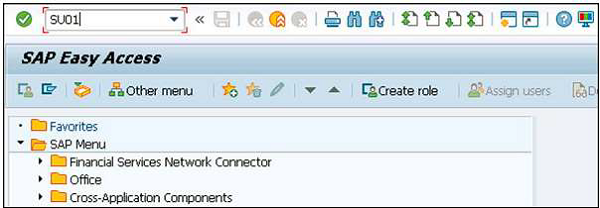
Step 2 − Enter the username you want to create and click the create icon as shown in the following screenshot.

Step 3 − You will be directed to the next tab - the Address tab. Here, you need to enter the details like the first name, the last name, phone number, email id, etc.

You will further be directed to the next tab − Logon Data as shown in the following screenshot.
Step 4 − Enter the user type under Logon data tab. We have five different user types.
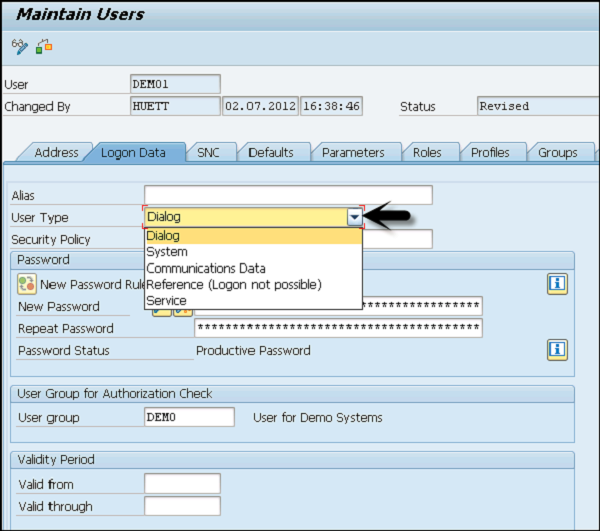
Following are the different user types −
Dialog user − This user is used for interactive system access from GUI.
System user − This user is used for background processing, communication within a system.
Communication user − This user is used for external RFC calls
Service user − This user is created for a larger and anonymous group of users.
Reference user − It is not possible to log on to the system with this user type. User type for general, non-person related users that allows the assignment of additional authorizations.
Step 5 − Type the first Login Password → New Password → Repeat Password.
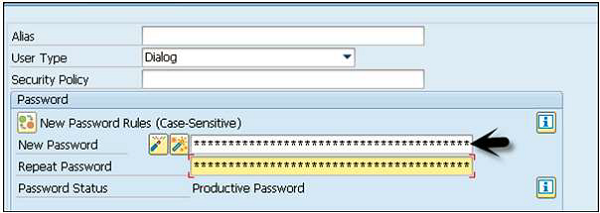
You will be directed to the next tab − Roles.
Step 6 − Assign the roles to the user.
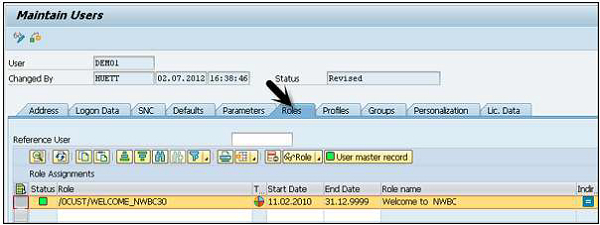
You will further be directed to the next tab − Profiles.
Step 7 − Assign the Profiles to the users.
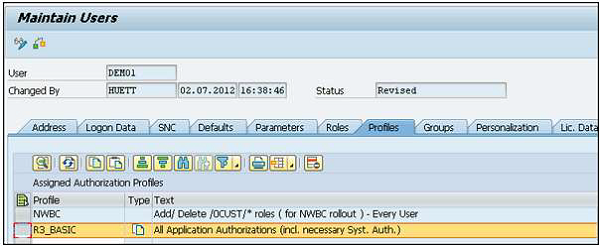
Step 8 − Click the Save icon to receive confirmation.
Lock/Unlock a User
In SAP system, an administrator can also lock or unlock a user as per the requirement. This can be performed for a specific time period or permanently. A user can be locked/unlocked in the following two ways −
- Manually/Forcefully
- Automatically (After number of failed login attempts)
Manually or Forcefully
You can lock a user forcefully/automatically using these transaction codes −
Transaction code − SU01 for single user
Transaction code − SU10 for multiple users
Step 1 − Execute transaction code − SU01
Step 2 − Select the user you want to lock/unlock and click the icon as shown in the following screenshot.

SAP NetWeaver - PFCG Roles
You can use this transaction (Transaction − PFCG) to manage roles in the ABAP system and to provide user authorization. You can create new roles, copy existing roles, define single and composite roles, etc.
Step 1 − In the following screenshot, enter the role name and click the Single/Composite role.
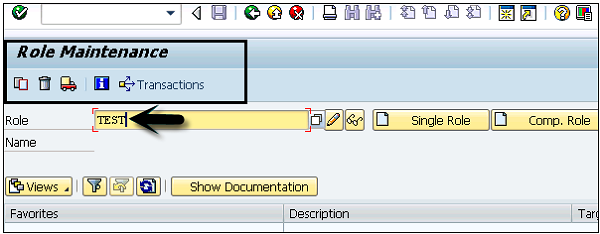
Step 2 − To copy an existing role, click the Copy Role button. Select the role from the list of the existing roles. You can select Single/Composite Role.
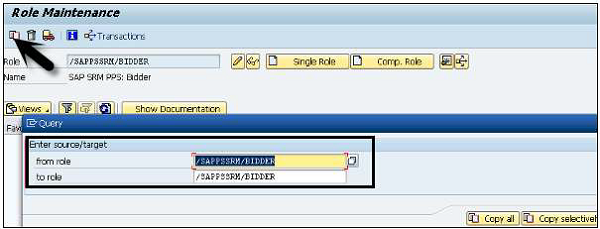
Step 3 − To change a role, select the role from the list and click the Change button as shown in the following screenshot.
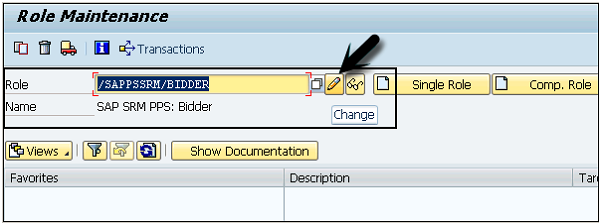
Step 4 − When you go to the User tab, you will see the list of users who have applied for this role. You can see their user id, user name, from and to date.
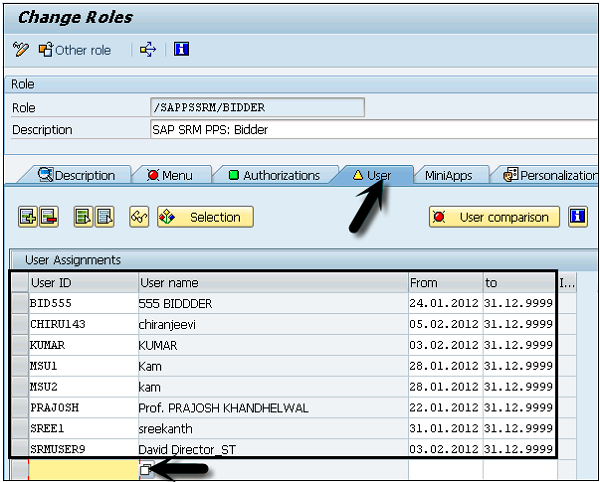
Step 5 − You can also perform a user comparison master record or you can add a direct user to this role.
SAP NetWeaver - Authentication Methods
To authenticate the user, the ABAP front-end server uses the authentication and Single Sign-On (SSO) mechanisms provided by SAP NetWeaver. Following mechanisms can be used for authentication
SPNEGO/KERBEROS
SPNEGO is used when a client application wants to authenticate to a remote server, but neither end is sure what authentication protocols the other supports. The pseudomechanism uses a protocol to determine what common Generic Security Services Application Program Interface (GSSAPI) mechanisms are available, selects one and then dispatches all further security operations to it. This can help organizations deploy new security mechanisms in a phased manner.
SAP Logon Tickets
SAP Logon Tickets represent user credentials in SAP systems. When enabled, the users can access multiple SAP applications and services through SAP GUI and web browsers without further username and password inputs. SAP Logon Tickets can also be a vehicle for enabling SSO across SAP boundaries. In some cases, logon tickets can be used to authenticate into third party applications such as Microsoft-based web applications.
X.509 Certificates
An X.509 certificate contains information about the identity to which a certificate is issued as well as the identity that issued it. Many of the certificates that people refer to as Secure Sockets Layer (SSL) certificates are in fact X.509 certificates.
SAP NetWeaver - Communication Security
Secure Network Communications (SNC) integrates SAP NetWeaver Single Sign-On or an external security product with SAP systems. With SNC, you strengthen security by using additional security functions provided by a security product that is not directly available with SAP systems.
SNC protects the data communication paths between the various client and the server components of the SAP system that use the SAP protocols, Remote Function Call (RFC) or Dynamic Information and Action Gateway (DIAG).
There are well-known cryptographic algorithms that have been implemented by the various security products, and with SNC, you can apply these algorithms to your data for increased protection.
Important Features
SNC secures the data communication paths between the various SAP system client and server components. There are well-known cryptographic algorithms that have been implemented by security products supported, and with SNC you can apply these algorithms to your data for increased protection.
With SNC, you receive application-level, end-to-end security. All communication that takes place between two SNC-protected components is secured.
Additional security features like Smart Cards can be used that SAP does not directly provide. You can change the security product at any time without affecting the SAP business applications.
Levels of Protection
You can apply three levels of security protection. They are −
- Authentication only
- Integrity protection
- Privacy protection
Authentication Only
When using authentication only, the system verifies the identity of the communication partners. This is the minimum protection level offered by SNC.
Integrity Protection
When using integrity protection, the system detects any changes or manipulation of the data, which may have occurred between the two ends of a communication.
Privacy Protection
When using privacy protection, the system encrypts the messages being transferred to make eavesdropping useless. Privacy protection also includes integrity protection of the data. This is the maximum level of protection provided by SNC.